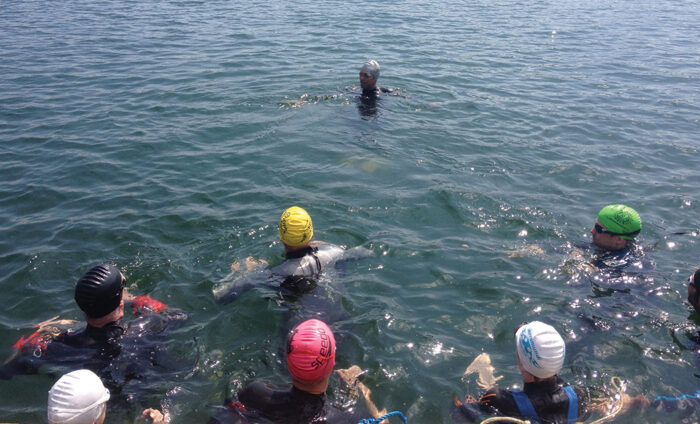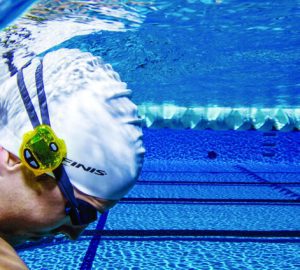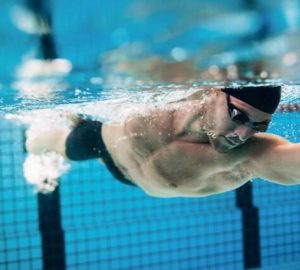
Training in open water
As a young age group swimmer my only experience of open water swimming had been on summer holidays to Devon or Cornwall or the occasional trip to France. It was not until my final year at Loughborough University in 1996 that I had the pleasure of a cold inland lake when I decided to have a go at triathlon.
It was a grey and cold May afternoon as I pulled on my Snugg wetsuit and looked out over the murky brown waters of Bosworth Water Trust in Leicestershire. Although the last thing I wanted to do was swim across this lake, I realised if I was going to seriously consider a move from swimming to triathlon I could not start worrying about water temperature and the unknowns in the water below! With the Steven Spielberg theme tune ringing in my ears (stupid when I look back on it I know, but we have all done it) I slid into the water and immediately started to hyperventilate as the cold water hit me. Being young and naïve I stuck my head in the water and sprinted off across the lake to try and get warm. About half way across the lake I turned around to see the rest of Loughborough Student triathlon team taking off their wetsuits and getting back into their warm clothes while laughing at me. They had been told earlier in the day that the water was far below the 12 degree Celsius minimum required for racing and that the triathlon at the weekend would now be a duathlon (run, bike, run) with no swim. They had decided not to tell me and initiate me into the sport of triathlon with a cold dip in the lake. I was later told the water was 8.5 degrees, somewhat colder than the 26 degrees I was used to.
Since that first episode in Leicestershire I have been fortunate enough to race triathlons and open water swim races on nearly every continent on the planet – Antarctica is the only one left!
As my triathlon career took off, it became apparent that if I was to be one of the best triathlon swimmers I needed to get used to the environment I was going to race in. Fortunately for me, a family friend’s house backed onto a small lake and as each subsequent summer and race season approached I would move from the pool into open water to train. I set about establishing a course in the lake and I still use the same out and back course around an island in the middle of that lake to this day. I don’t know the exact distance of the course but don’t really need to, as I know it stays the same year on year. The most important thing I need to know is the time it takes to swim the course. I developed a main set of 10 times across and back to the island going off a four-minute turnaround. I learnt that if I could manage all ten under 3mins 30secs then I was in good enough shape to lead world cup races and championships. I set personal bests over the same course, one with a wetsuit, one without, one for kicking, one for band only and one with band and paddles. I used all these times to gauge fitness and strength levels. My little lake course had become a big swimming pool.
So it was a surprise when I set up my first lake for public use that a very common trait of athletes was to swim entire laps of the lake rather than shorter intervals. I completely understand that if you are a novice to open water, and have perhaps just entered your first race, then making sure your can cover the entire race distance in one go without stopping or touching a wall is a must. But to watch many experienced swimmers and triathletes training without any structure in their open water sessions was odd to me.
It is a well-established fact that interval training is the fastest way to improve fitness and speed. So it seems logical that if you train using intervals in the pool you should train using intervals in open water. In open water it is extremely difficult to assess whether you are holding pace on long swims around a lake. In a pool if you are swimming a 1500m rep it is possible to look at the pace clock after each 50m or 100m and determine if you are holding times. Therefore the solution is to swim shorter intervals in open water around short courses. This leads to faster improvements in the open water skills of sighting, turning around buoys and, if swimming with others, drafting. Wearing a waterproof wristwatch allows you to take your times and establish those personal bests. As long as your local lake keeps the swim course the same through out the season, you can watch your times improve and fitness levels increase.
With more lakes offering pace clocks at the start and finish of laps and multiple laps to choose from, it is becoming easier and easier to turn your local open water swimming facility from just a lake into the ultimate swim training venue.
Key Points for Training in Open Water
- If you are racing in open water, train in open water for a portion of your training.
- Be aware of water temperatures and your body’s reactions to cold water. You can learn to acclimatise but make this a gradual process.
- Don’t sprint off when you first get into cold water. Give your heart rate and body a chance to get used to the cold environment.
- Establish a regular breathing pattern (i.e. breathing every second or third stroke) to avoid hyperventilating in cold water.
- Turn your open water venue into the ultimate swim training venue by using a watch or pace clock and swimming intervals.
- Sight often to ensure you swim in a straight line.
- Practise using open water swim skills while operating above or around race pace during training to help ensure those skills are there when you need them during a race.






